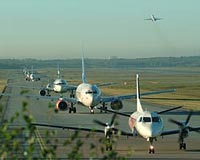 |
Taipei (AFP) Dec 13, 2009 Taiwan-based China Airlines, which marks its 50th birthday this week, can look back at half a century of turbulence, but the future could bring even more formidable challenges, analysts say. While in the past an abysmal safety record was the main problem, now the carrier faces completely different threats from China's aggressive state-controlled airlines and the region's nimble low-cost carriers. "It's a company that has come through years of external shocks and storms probably shaken but still fighting," said Derek Sadubin, an analyst with the Centre for Asia Pacific Aviation, a Sydney-based consultancy. "They've got the support of the Taiwan government behind them, which has given them a degree of confidence, but it's an airline that really needs to step up a gear to face the challenges ahead." Starting out on December 16, 1959 with just two World War II-era flying boats, China Airlines has grown into an international carrier with a fleet of 66 modern aircraft. What has also grown with the company, which is 54-percent owned by a state fund, is a record of spectacular crashes that have made it one of the riskiest carriers in Asia. Among the more recent, in May 2002 a Boeing 747 smashed into the Taiwan Straits, killing all 225 people on board. Five years later, a Boeing 737 burst into flames while landing in Okinawa, although without fatalities. A propensity for risk-taking among the carrier's pilots, who for decades were recruited mainly from the island's air force, has often been pinpointed as a liability. "Their staff are more like government employees than their counterparts in other companies," said Bruce Tsao, a Taipei-based analyst with Capital Securities. "It's an old company with a government background. That mentality may be related to its safety track record." The carrier's reputation for poor safety has forced it to take a series of steps aimed at renewal "from inside out," said Debbie Wu, a public relations expert at Fu-Jen Catholic University in Taipei. "This ranges from organisational reconstruction to buying new jets and designing new uniforms, and the consumers have noticed the changes," she said. "The public is forgetful, and the airline has diverted attention from the negative news by creating new topics with these moves. It has successfully turned its image around." But one thing has not changed: the company's name, which dates from a time when Taiwan's leaders, refugees from the communist-controlled mainland, still claimed to represent all of China. China Airlines may in fact be a more apt name now than it has been for a long time due to the enormous opportunities associated with the booming mainland market. A thaw in relations between China and Taiwan means the carrier now operates 55 weekly flights to 13 cities on the mainland. While it faces competitors from both Taiwan and the mainland, the mainland routes are a sure earner due to rules that exclude foreign airlines. "Basically most players in this market are winners," said Francis Hsiao, a Taipei-based analyst with Grand Cathay Securities. This has proved the salvation not just of China Airlines, but also of EVA Airways, the other major Taiwanese carrier, analysts argue. "Without that pressure valve it would have been a disastrous environment for them, but it's not a panacea for the Taiwanese carriers," Sadubin said. "Increasingly, aggressive and powerful mainland carriers are operating non-stop services over the Pacific and to Europe, which has been the bread and butter for Taiwanese carriers for decades." On top of this, China Airlines is up against crushingly efficient budget airlines, chipping away at its other main source of revenue: short-haul flights. "They really are exposed to a competitive outlook," said Sadubin. Senior executives at China Airlines declined to be interviewed for this story. Share This Article With Planet Earth
Related Links Aerospace News at SpaceMart.com
 Greener landings in climate-aware Sweden
Greener landings in climate-aware SwedenIn The Cockpit Of An Airbus A321 (AFP) Dec 4, 2009 At 9,000 metres, the pilot idles the engines and begins gliding the Airbus toward Stockholm's Arlanda Airport in a fuel-slashing "green landing". By pulling back the engines, pilot Henrik Ekstrand is saving his charter company, Novair, 300 litres (66 gallons) of fuel -- cutting costs and carbon emissions in an industry under financial and environmental pressure. His flight is also an ... read more |
|
| The content herein, unless otherwise known to be public domain, are Copyright 1995-2009 - SpaceDaily. AFP and UPI Wire Stories are copyright Agence France-Presse and United Press International. ESA Portal Reports are copyright European Space Agency. All NASA sourced material is public domain. Additional copyrights may apply in whole or part to other bona fide parties. Advertising does not imply endorsement,agreement or approval of any opinions, statements or information provided by SpaceDaily on any Web page published or hosted by SpaceDaily. Privacy Statement |